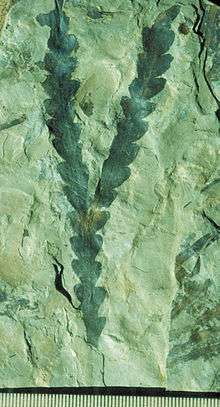Dicroidium odontopteroides
Dicroidium odontopteroides was a common and widespread species of Dicroidium known from South Africa, Australia, New Zealand, South America and Antarctica. The species was first discovered in Triassic sediments of Tasmania and described by the palaeontologist John Morris in 1845.[1]
| Dicroidium odontopteroides | |
|---|---|
 | |
| Dicroidium odontopteroides fossil leaf, Late Triassic Molteno Formation near Birds River South Africa. | |
| Scientific classification | |
| Kingdom: | Plantae |
| Clade: | Tracheophytes |
| Division: | †Pteridospermatophyta |
| Order: | †Peltaspermales |
| Family: | †Corystospermaceae |
| Genus: | †Dicroidium |
| Species: | †D. odontopteroides |
| Binomial name | |
| †Dicroidium odontopteroides (Morris) Gothan | |
Description
The leaves of Dicroidium odontopteroides differ from other species of Dicroidium in being unipinnate and having short rounded pinnae.
Whole plant reconstructions
Dicroidium odontopteroides may have been produced by the same plant as Umkomasia macleanii (ovulate structures) and Pteruchus africanus (pollen organs), based on cuticular similarities between these leaves and reproductive structures at the Umkomaas locality of South Africa.[2]
gollark: bëëëëës
gollark: None are safe, heavserver is inevitable.
gollark: Protocol 921-FS will be initiated.
gollark: :lungs: 🥦 :wood:
gollark: <:yesm:747159422236885112>
References
- Strzelecki, P.E. (1845). Physical descriptions of New South Wales and van Diemens Land. Brown, Green and Longmans, London. pp. 422 pp.
- Thomas, H.H. (1933). "On some pteridospermous plants from the Mesozoic rocks of South Africa". Philosophical Transactions of the Royal Society B. 222: 193–265. doi:10.1098/rstb.1932.0016.
This article is issued from Wikipedia. The text is licensed under Creative Commons - Attribution - Sharealike. Additional terms may apply for the media files.